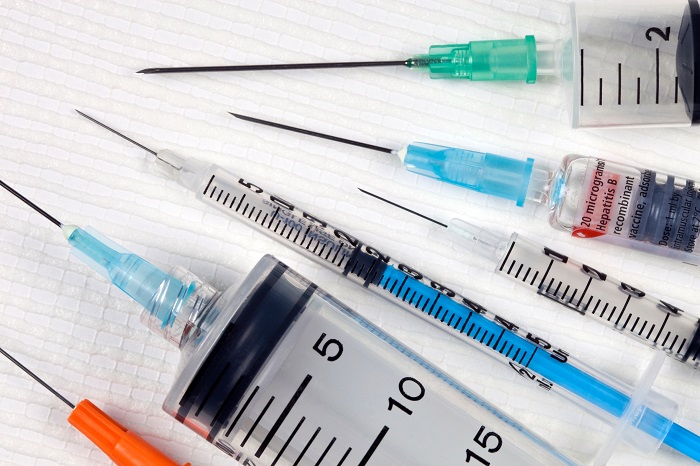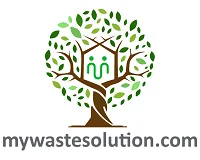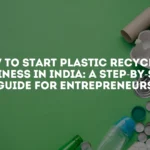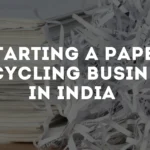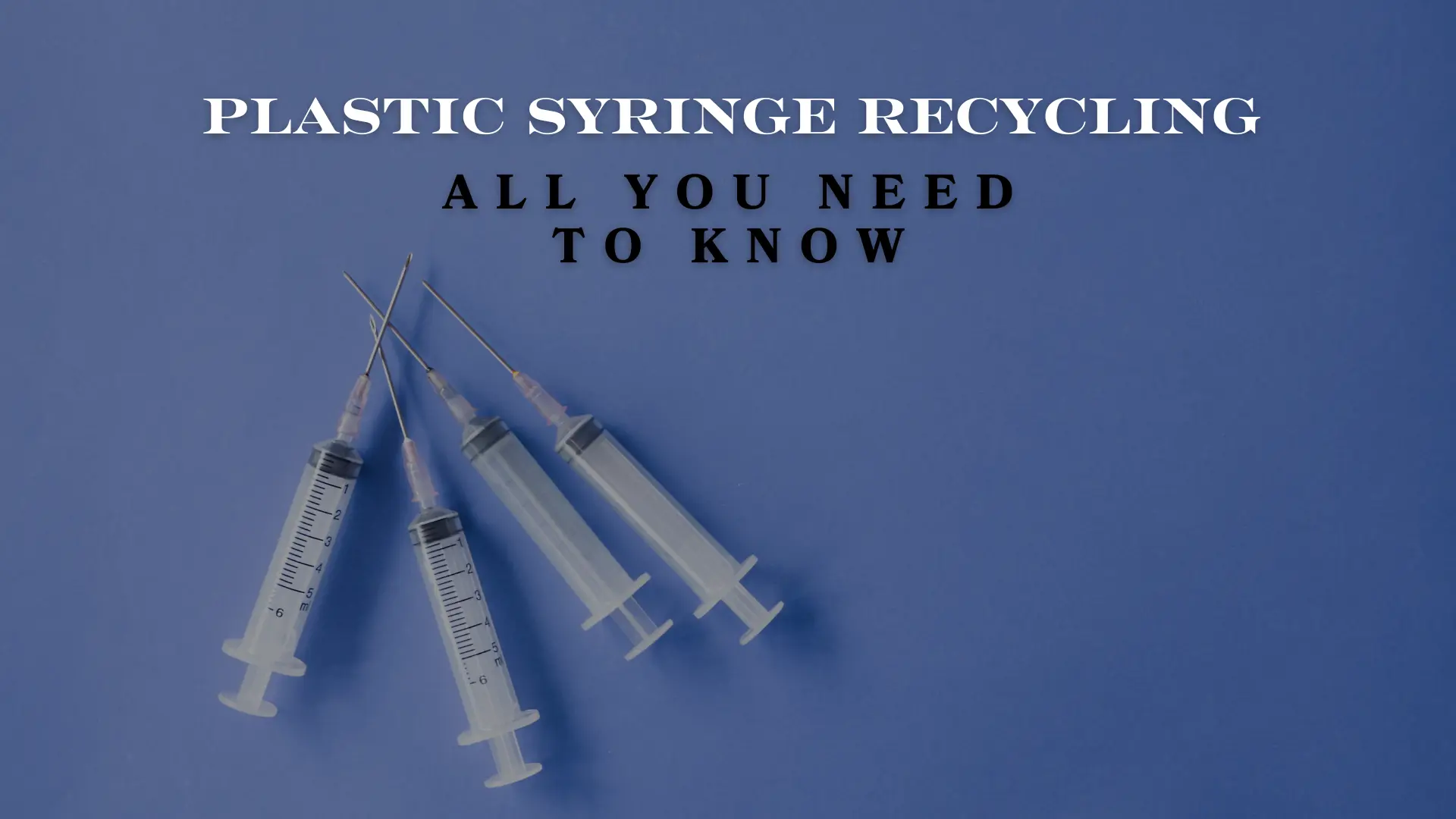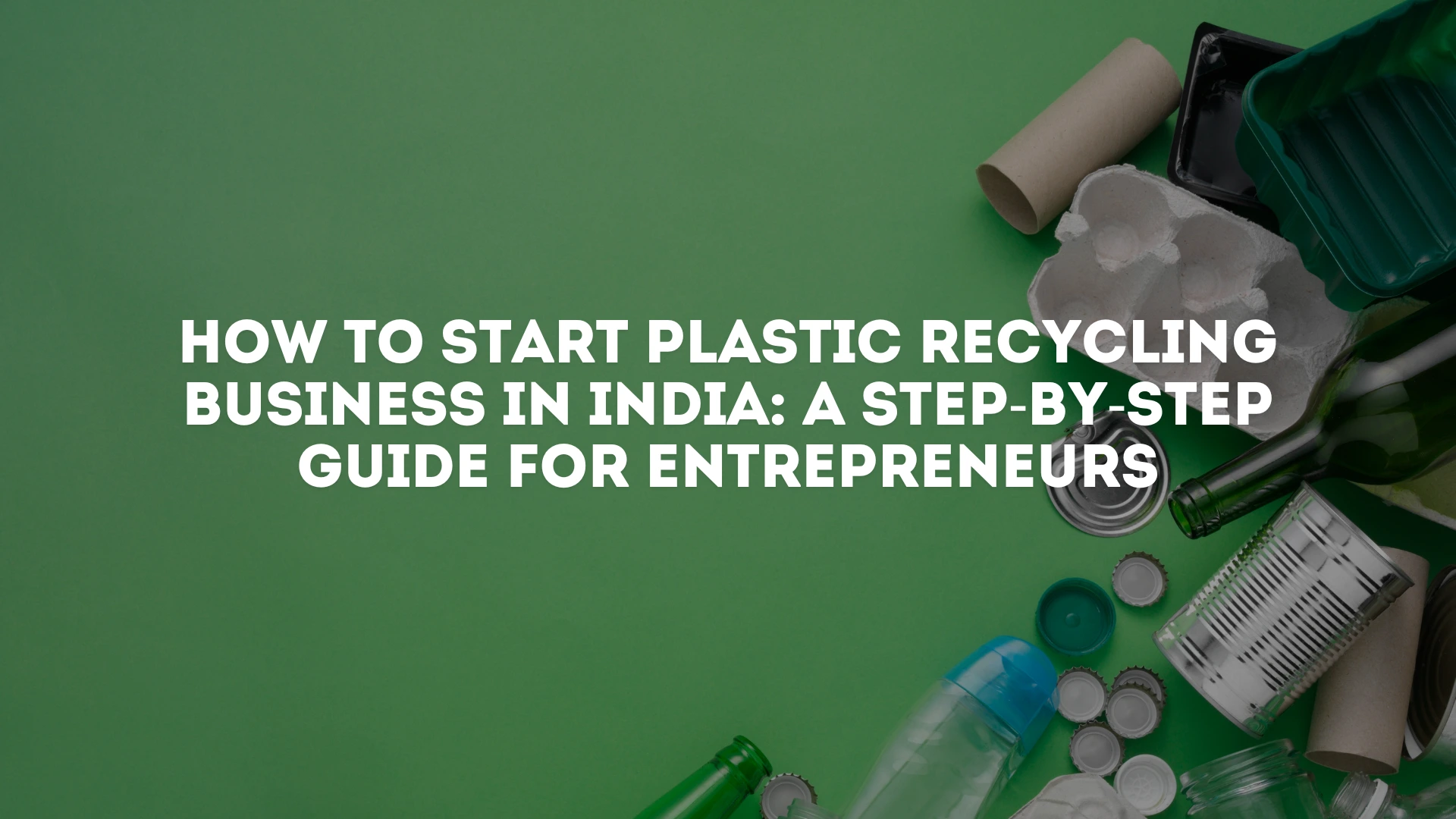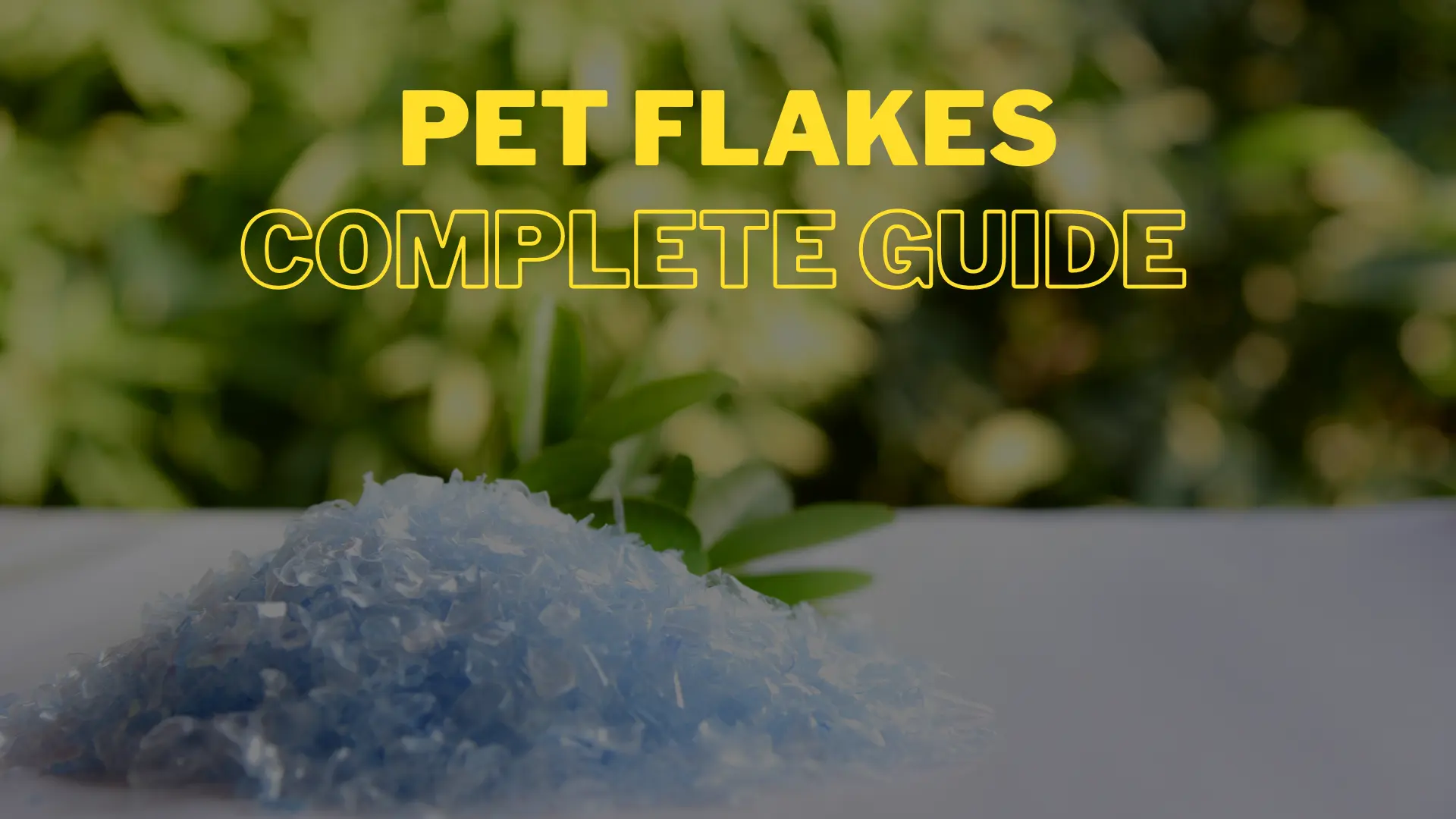Plastic syringe recycling has many possibilities. All over the world a large amount of biomedical waste is being generated at healthcare facilities. Especially in pandemics; covid-19 period is reported to have a huge plastic waste generation. From masks to plastic syringes, all were dumped in landfill after one time use. This was observed to be a serious problem, as huge amounts of biomedical waste was dumped into the landfill without proper treatment.
However, only a small fraction is recycled. You guys are very well aware that conventionally, the used plastics are either disposed of in landfills or inadequately incinerated. Recycling of plastics is definitely a solution to solve plastic pollution. Medical plastic recycling is limited mainly due to difficulties involved in sorting or cleaning. Recycling biomedical plastic wastes is possible only through good coordination between the healthcare sector and recycling industries. New recycling technologies are to be adopted in a sustainable manner. Moreover, we should look that the plastics used in the biomedical sector should be designed such that recycling is possible. It makes our work more easy and convenient, if the product is made of recyclable materials.
So in this blog we are going to talk about plastic syringe recycling. We are going to learn about different ways involved in the process of recycling and difficulties associated with plastic syringe recycling. Before that, take a look at what are the hazards if a plastic syringe is not collected and disposed of properly.
Hazards associated with plastic syringe
Although we are very well aware of how dangerous biomedical waste can be if it is not disposed of properly. Given below are the hazards which are associated with plastic syringe waste which you must know! For more information on hazards related to bio-medical waste, connect with our bio-medical waste consultants!
- Harm to the medical staff involved if used syringes are not disposed properly.
- Collected from the health care sector or field, there is a risk of accidentally pricking themselves with the used sharps.
- If these syringes are infected, they could pose a risk of transmitting HIV or other blood borne infections to the workers or who are collecting syringes after one time use.
- Sometimes, others Injecting Drug Users (IDUs) reusing them, if the used sharps are scattered in public places or not properly stored in the Drop In Centre (DIC).
- The IDUs might pick them up and reuse them.which may lead to transmission of HIV and other blood borne infections.
- Reuse of contaminated syringes causes infections or disease including HIV or Hepatitis B and C.
- If the used sharps are scattered around, children around the area may play with them leading to accidental pricking with the used sharps, thus risking transmission of HIV or other blood borne infections.
Now,as you understand, how dangerous it can be if we leave plastic syringes around without proper treatment. So, let’s have a look at statistical data associated with biomedical waste disposal in India. You can have a look at the table given below!
Treatment and disposal of biomedical waste across India from (2007- 2018)
in metric tons per day
| Year | Treatment and disposal (in metric tons per day) |
| 2018 | 530 |
| 2017 | 515 |
| 2016 | 501 |
| 2015 | 486 |
| 2010 | 303 |
| 2007 | 288 |
Now we know that reuse of syringes results in transmission of infections and is a big risk to human life. So, safe disposal and recycling of used syringes is necessary to prevent spreading of infection.
Let’s move further and see how plastic syringes are recyclable!
Explore Plastic Waste Recycling Solutions
Find top machinery, plants, tools, resources, companies, and consultancy for comprehensive plastic syringe recycling needs.
Recycling plastic syringes
“Recycling makes a huge difference.”
Syringes in the medical field, classified as biohazardous waste or sharp waste. Biohazardous waste is the waste that has come in contact with contaminated body fluid or saturated blood. So as discussed earlier, this can risk human life, if accidental pricking takes place. So it’s become more important to recycle syringes more safely with proper precautions and hygiene.
What material is used for making syringes?
As we talk about recycling, you should know that syringes are made with recyclable plastic materials. Their type of plastics is polypropylene (PP) and polyethylene (PE) plastics. This means that based on the materials they are made of, we can recycle them. But this is not enough you need to know. It has a very long journey to follow! This kind of plastic takes an extremely long time to decompose. On average, plastic material may take up to thousands of years to break down into microplastic. Then further, these microplastic remain in the soil for another considerable number of years. So, proper care should be taken! Let’s go a little bit further, and know how it can be possible.
How to dispose plastic syringe with safety
As we discussed, needles and syringes are often disposed of in the bin. Because of their constant contact with body fluid and blood. This is the major reason why syringes are always not recycled despite the fact that they are made with metal or recyclable materials. Although with advanced technology, we can observe many innovative ideas are approaching to tackle this problem.
Now, let’s first learn proper disposal of syringes. If you are disposing of your syringes as a sharp waste, you have to get a sharp waste container. These containers are usually labelled or you can see biohazard symbols on them. Once you get the plastic syringes or any other biomedical waste, you will put your used syringes or plastic in them. Remember that, if you are disposing of your syringes as a sharp waste from a hospital or any facility, you will have to include some details. Details like name of your facility, phone number, and address etc. Depending on your state’s law. Also, you can call for a pick-up of the sharp waste or wait for the designated weekend to dispose of them.
In another scenario, when you are disposing of your syringes as biohazardous waste, you have to get a biohazardous waste bag. Usually, these bags are red and are either labelled as bio hazardous or have a symbol. Once you get this bag, you will put your syringes in it. Like disposing of syringes as a sharp waste, this also requires the details of the disposer. Once you have done this, you can put the bagged syringes in a biohazardous waste bin. These bins are usually covered with lids and lined with red plastic bags too.
Struggling with plastic syringe recycling issues? Connect with top consultants specializing in plastic waste management.
Connect NowRecycling process
Until now we are aware that the main factor that limits the syringe recycling procedure is the difficulty in sorting the plastic waste and risk of transmitting potential infections. However, the lack of sufficient landfills for waste disposal makes recycling the need of the hour. So let’s explore the recycling of plastic waste associated with the biomedical waste process in detail.
First thing you should know is that recycling starts with identifying the materials for recycling. Then it’s followed by sorting of the materials. Generally, manual sorting is done. However the process is labour intensive. Here plastics are sorted based on their colour, shape, type of material etc. Nowadays, automated sorting techniques receive immense attention. Near infrared (NIR) provides a high speed of identification. This technique is effective for transparent plastics. X-ray fluorescence technique based on the organic nature of polymer has been used for separating PVC from PET. Many separation techniques such as density separation,froth flotation techniques that use surfactants, electrostatic sorting, air sorting etc, are employed. This technique ensures that recyclable materials are sorted quickly.
Once the plastic wastes are collected, sorted and cleaned, there are usually four common plastic recycling routes as given below:-
- Primary recycling
- Secondary recycling
- Tertiary recycling
- Quaternary recycling
- Primary recycling refers to the reuse of plastic scraps into products having similar characteristics of the original material. In fact you will be amazed to know that PET can be recovered from used bottles for making similar new bottles. The recycled scrap or waste plastics can be mixed with virgin material to ensure the required product quality. This process is highly established and is also known as a closed loop process. Usually, this technique is used for single type plastics. These recyclable plastics are comparatively clean or uncontaminated. One of the best advantages of closed loop recycling is that the discarded wastes are easily integrated back into the production cycle.
- Secondary recycling is also known as mechanical recycling. It is the recovery of plastic wastes by mechanical means or techniques. This type of recycling involves collection, separation and sorting,washing to remove organic or other contaminants, and grinding of the material. Helps in retaining mechanical properties. You know that there’s a drop in molecular weight after recycling and contamination with other polymers. This can result in reduction of mechanical properties. Moreover, due to the reprocessing, recycled plastics are prone to thermo mechanical degradation. It is difficult to achieve mechanical recycling with highly contaminated waste. An example of secondary recycling is in the production of flooring tiles from mixed polyolefins. Secondary recycling involves various methods of recycling like screw extrusion, injection moulding, blow moulding etc.
- Tertiary recycling or also known as chemical recycling. It converts plastic materials into smaller molecules, usually liquids or gases. Further, that is used as the feedstock in a process that generates chemicals and fuels. Chemical recycling uses a chemical process to recover the petrochemical components in plastics. An example of this approach is pyrolysis, in which plastics are subjected to high temperatures in the presence of catalysts. The plastic waste is subjected to high temperature and pressure thereby making the long chain polymers to small chain polymers which can be degraded easily, with less complication. Pyrolysis is an effective way to deal with plastic waste. The pyrolysis leads to three different byproducts; they are- oils, gases and hydrochar. The oil can be used in many applications like furnace oil. Also the gas formed, usually termed as syngas can be used to replace the natural gas or coal in many of the applications. So we can say that the final output from pyrolysis depends on feedstock and the technology.
Recently, the process of conversion of PP face masks and PVC gloves into fuel energy by pyrolysis. The thermal treatment was performed at 400°C for 1 h in the closed air system and pyrolysis converted more than 75% of waste to bio-crude oil (tar). Beside this there are many other methods of recycling too! This includes cracking, gasification and chemolysis. Pyrolysis is done in the absence of air. If the process is done in controlled environments, it is called gasification.
- Quaternary recycling or incineration is a technique that considerably reduces the waste volume and involves energy recovery from waste plastic by incineration. So, this is usually employed when the wastes are highly contaminated and cannot be recycled by normal means. Tire-derived fuel (TDF) is a best example of quaternary recycling. This is also known as the incineration process and results in waste residues and ultimately pollution. The combustion usually releases harmful gases which can be controlled by adding activated carbon, acid neutralisation, adding ammonia to the combustion chamber etc. The waste is reduced to almost 1% of initial volume and can effectively decompose toxic or contagious waste. Hence now you know that, this is an ideal recycling technique for medical wastes.
Find and connect with leading companies specializing in plastic syringe recycling.
Get Connected Today
How plastic syringe recycling is possible
As plastic syringes are assumed to be infectious and cannot be sent along with the common municipal waste. In this scenario, the waste plastic must be decontaminated by making it into small pieces and then heating it at an elevated temperature. This in turn can be sent along with the municipal plastic waste.
Non-profit organisations are trying to reuse many unused medical syringes (including other biomedical waste too) by supplying to medical relief camps in developing nations. This is by categorising materials which might be expired but unopened but not contaminated. All these procedures can reduce the waste being generated.
Some countries also employ steam sterilisation before reuse, like in Korea where these supplies are subjected to a temperature of 121°C at 1 atm pressure for a 30 min duration. If all these are performed in an organised and systematic manner, the amount of waste being
generated can be reduced, well before recycling.
Some of the common plastic wastes are the sterilisation wraps which are used to prevent contamination of the surgical instrument, majorly the syringes. This is generally made of polypropylene and if collected before the surgical procedures, this can be recycled effectively and efficiently. Some of the intravenous transfusion bottles, prepared from polypropylene or high density polyethylene, can be recycled efficiently, if it’s segregated well before it gets contaminated. Biomedical waste, especially plastic syringes, prepared from polystyrene (PS),polyvinyl chloride (PVC), polypropylene (PP), polyethylene (PE) etc; these all have a great potential to recycle!
So as syringes are made from polypropylene (PP), polyethylene (PE) plastic. So let’s see how these can be recycled! Our recycling consultants can help you achieve efficient recycling of plastic syringes!
Polypropylene (PP)
Due to its high chemical resistance, high transparency, toughness and bacterial resistance PP is used in various medical applications especially in the packaging sector. Medical grade PP also has good resistance to steam sterilisation. Disposable syringes are extensively manufactured from PP. Disposable syringes made from PP are having many advantages over conventional glass syringes such as light weight, crack resistant, leak proof, easily disposable, eco-friendly, sterilisable, see through clarity etc.
PP is also used for making non absorbable surgical sutures. Vascular anastomosis is
typically performed by using polypropylene sutures. The change in mechanical properties of recycled polypropylene was studied. PP was recycled several times and virgin PP were prepared and the tensile studies were carried out. There was not much difference in the mechanical properties between the blends containing recycled PP and blends containing virgin PP. Moreover, the studies demonstrated that it is possible to incorporate more than 70% w/w of recycled polypropylene without affecting the mechanical properties.
Struggling with plastic waste buying and selling issues? Connect with plastic waste buyers and sellers here.
Buyer Listings Seller ListingsThe pyrolysis of the syringe body at a temperature range of 400 to 550°C and at a heating rate of 20°C per minute was studied. At 450°C, 83 wt % liquid yield was obtained. The physical properties of the pyrolysis oil matched diesel and petrol mixtures.
A preliminary study reported on the recycling of PP based surgical face masks into sound porous absorbers. The sound absorption performance of the recycled materials was comparable to that of the commercial ones. This study opens new perspectives for the recycling of surgical masks which are accumulating at a higher rate during this pandemic environment.
Similar work for utilising PP, of single use biomedical waste to improve the mechanical properties of concrete were studied. Recycling of used disposable plastic syringes as fibres reinforced concrete is also possible with proper procedure. Thus the study shows that addition of single use biomedical waste such as syringes, even at small volumes can result in enhancement of mechanical properties of concrete.
Polyethylene(PE)
Polyethylene polymers are light, flexible, chemically inert, and have great resistance to organic solvents. Different grades of PE like high density (HDPE), low density (LDPE), high density high molecular weight polyethylene (HMHDPE) and linear low-density polyethylene (LLDPE) are used for medical applications.
PE has been employed for making syringes, catheters, polyethylene cups for joint replacements, implants and so on. Interestingly, engineers at MIT designed wearable textiles from PE. They weaved PE into fibres that absorb and evaporate water more rapidly than commonly used textiles demonstrating their potential application in the textile industry. This work clearly provides new understanding to recycle waste PE into wearable textiles.
The recycling of HDPE showed that the mechanical and rheological properties were dependent on the processing conditions. The use of extruders having higher residence times reduced the mechanical properties. Composite panels made from recycled HDPE using hot-press moulding with wood flour as filler showed excellent dimensional stability when compared to that made from virgin HDPE. Moreover, addition of 3-5 wt% maleated polypropylene (MAPP) in the composite formulation improved both the stability and mechanical properties. The pyrolysis of waste polyethylene was reported. They analysed the effect of operating conditions like temperature, residence time, and carrier gas flow rate on the liquid fuel production.
Fourier-transform infrared spectroscopy (FTIR) analysis of the liquid fuel showed characteristics of diesel. It was concluded that high temperature, long residence time and high carrier gas flow rate were beneficial to the formation of the liquid fuel’s heavy fraction. Incorporation of natural fibres to recyclates enhances their mechanical properties. Bagasse fibre, stone-dust and aluminium alloy particles were added to recycled high-density polyethylene matrix. Compared to the neat HDPE matrix, bagasse fibre, stone-dust and aluminium alloy particles incorporated matrix showed 39% enhancement in ultimate tensile strength. So recycling of plastic syringes is possible but proper care and precautions should be taken!

Explore the best plastic waste machinery, plants and equipment for plastic syringe recycling.
Connect TodayStrategies that can apply to manage plastic syringe waste efficiently
Plan, Act & Execute!
- Making the medical professional understand the value of recycling.
- The recycler should understand that not all the material coming recycling is contaminated or hazardous.
- Collection of segregated materials from hospitals.
- Preparation of the internal collection system at each source.
- Materials must be segregated and categorised at the source.
- The proper training of the staff at the medical institutions on the proper handling of the recyclable materials.
- Reusing after sterilisation whenever possible.
- Correct separation of the medical plastics is important for efficient recycling.
So by applying these simple strategies we are not only responsible for reducing waste to landfill but also ensure that we make our work easy for further processes.
As you now understand the importance of plastic syringe recycling, remember from next time whenever you use them disposed of with proper treatment. Connect with our plastic waste consultants for proper management of plastic waste!
